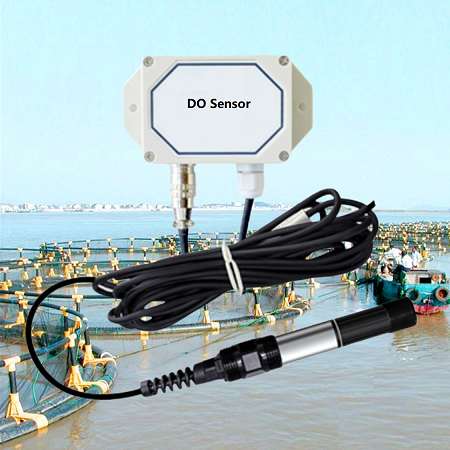Working Principle
Polarographic dissolved oxygen sensors operate based on electrochemical principles, primarily utilizing the Clark electrode. The sensor consists of a gold cathode, a silver anode, and a specific electrolyte, all enclosed by a selective permeable membrane.
During measurement, oxygen diffuses through the membrane into the sensor. At the cathode (gold electrode), oxygen undergoes reduction, while at the anode (silver electrode), oxidation occurs. This process generates a diffusion current proportional to the dissolved oxygen concentration in the sample, enabling precise measurement.
Key Features
Polarographic dissolved oxygen sensors are widely adopted due to their exceptional characteristics:
- High Accuracy and Sensitivity:
- Capable of detecting trace-level dissolved oxygen, with measurement ranges as wide as 0.01μg/L to 20.00mg/L and resolutions as high as 0.01μg/L. This is critical for applications like boiler feedwater and semiconductor ultrapure water monitoring.
- Fast Response Time:
- Typically responds in under 60 seconds (some products achieve response times within 15 seconds), quickly reflecting changes in dissolved oxygen levels.
- Low Maintenance Requirements:
- Modern designs often do not require frequent electrolyte replacement, reducing long-term maintenance costs and efforts. However, periodic calibration and membrane replacement are still necessary.
- Strong Stability and Anti-Interference Capability:
- The selective permeable membrane effectively isolates impurities and contaminants, ensuring stable and reliable measurements.
- Automatic Temperature Compensation:
- Most sensors include a built-in temperature sensor for automatic temperature compensation, correcting measurement errors caused by temperature fluctuations.
- Smart and Integrated Design:
- Many sensors are equipped with communication interfaces (e.g., RS485) and support standard protocols (e.g., Modbus), enabling integration into automation control systems and IoT platforms for remote data monitoring.
Application Scenarios
Polarographic dissolved oxygen sensors are widely used across various industries:
- Industrial Processes and Water Treatment:
- Boiler Feedwater Monitoring: Critical in industries like power generation, chemicals, and metallurgy, where excessive dissolved oxygen can cause severe corrosion of metal pipelines and equipment.
- Wastewater Treatment and Discharge Monitoring: Dissolved oxygen levels directly impact microbial activity in municipal and industrial wastewater treatment processes.
- Semiconductor and Ultrapure Water Production: High-purity water requirements in electronics manufacturing necessitate precise monitoring of trace dissolved oxygen.
- Environmental Monitoring and Scientific Research:
- Surface Water, River, and Lake Quality Monitoring: Dissolved oxygen is a key indicator of water self-purification capacity and ecological health.
- Aquaculture: Real-time monitoring of dissolved oxygen helps prevent hypoxia in aquatic organisms, improving farming efficiency.
- Biotechnology and Pharmaceutical Industries:
- Dissolved oxygen concentration must be precisely controlled in bioreactors (e.g., fermentation and cell culture) to ensure optimal growth conditions for microorganisms or cells.
- Food and Beverage Industry:
- Dissolved oxygen levels can affect product taste, color, and shelf life, making monitoring essential during production.
Commonly Used Countries/Regions
The adoption of polarographic dissolved oxygen sensors is closely tied to industrialization levels, environmental regulations, and technological advancement:
- North America:
- The United States and Canada enforce stringent environmental protection regulations and water quality standards, making these sensors widely used in high-end industries like power, chemicals, and pharmaceuticals.
- Europe:
- Countries like Germany, the UK, and France, with strict environmental policies (e.g., the EU Water Framework Directive) and advanced wastewater treatment technologies, are major consumers of these sensors.
- Asia-Pacific:
- China: Rapidly growing demand due to heightened environmental protection efforts (e.g., the “Water Ten Plan” policy) and developments in water treatment and aquaculture.
- Japan and South Korea: Advanced electronics, semiconductor, and precision chemical industries drive diverse needs for high-precision water quality monitoring equipment.
- Other industrialized regions with strict environmental regulations also widely use these sensors.
Summary Table
| Aspect | Description |
|---|---|
| Principle | Polarographic method (electrochemical), Clark electrode, oxygen diffusion current proportional to concentration. |
| Range & Precision | Wide range (e.g., 0.01μg/L ~ 20.00mg/L), high resolution (e.g., 0.01μg/L), suitable for trace-level monitoring. |
| Response Time | Typically <60 seconds (some <15 seconds). |
| Maintenance | Low maintenance (no frequent electrolyte replacement), but periodic calibration and membrane replacement needed. |
| Anti-Interference | Selective membrane isolates impurities, ensuring stability. |
| Temperature Compensation | Built-in temperature sensor for automatic compensation. |
| Smart Features | Communication interfaces (e.g., RS485), support for protocols (e.g., Modbus), IoT integration. |
| Applications | Boiler feedwater, wastewater treatment, ultrapure water, environmental monitoring, aquaculture, biotechnology. |
| Common Regions | North America (US, Canada), Europe (Germany, UK, France), Asia-Pacific (China, Japan, South Korea). |
Conclusion
Polarographic dissolved oxygen sensors, with their high accuracy, fast response, and stability, are indispensable tools in water quality monitoring and analysis. They play a vital role in ensuring industrial safety, efficiency, and environmental protection.
We can also provide a variety of solutions for
1. Handheld meter for multi-parameter water quality
2. Floating Buoy system for multi-parameter water quality
3. Automatic cleaning brush for multi-parameter water sensor
4. Complete set of servers and software wireless module, supports RS485 GPRS /4g/WIFI/LORA/LORAWAN
For more water sensor information,
please contact Honde Technology Co., LTD.
Email: info@hondetech.com
Company website: www.hondetechco.com
Tel: +86-15210548582
Post time: Aug-25-2025


